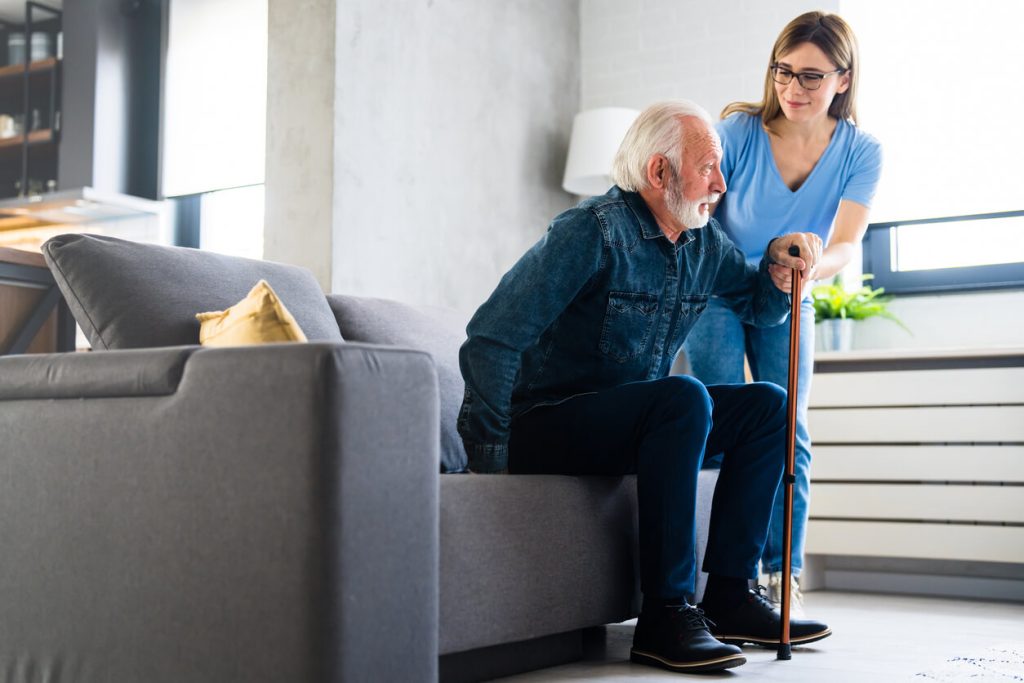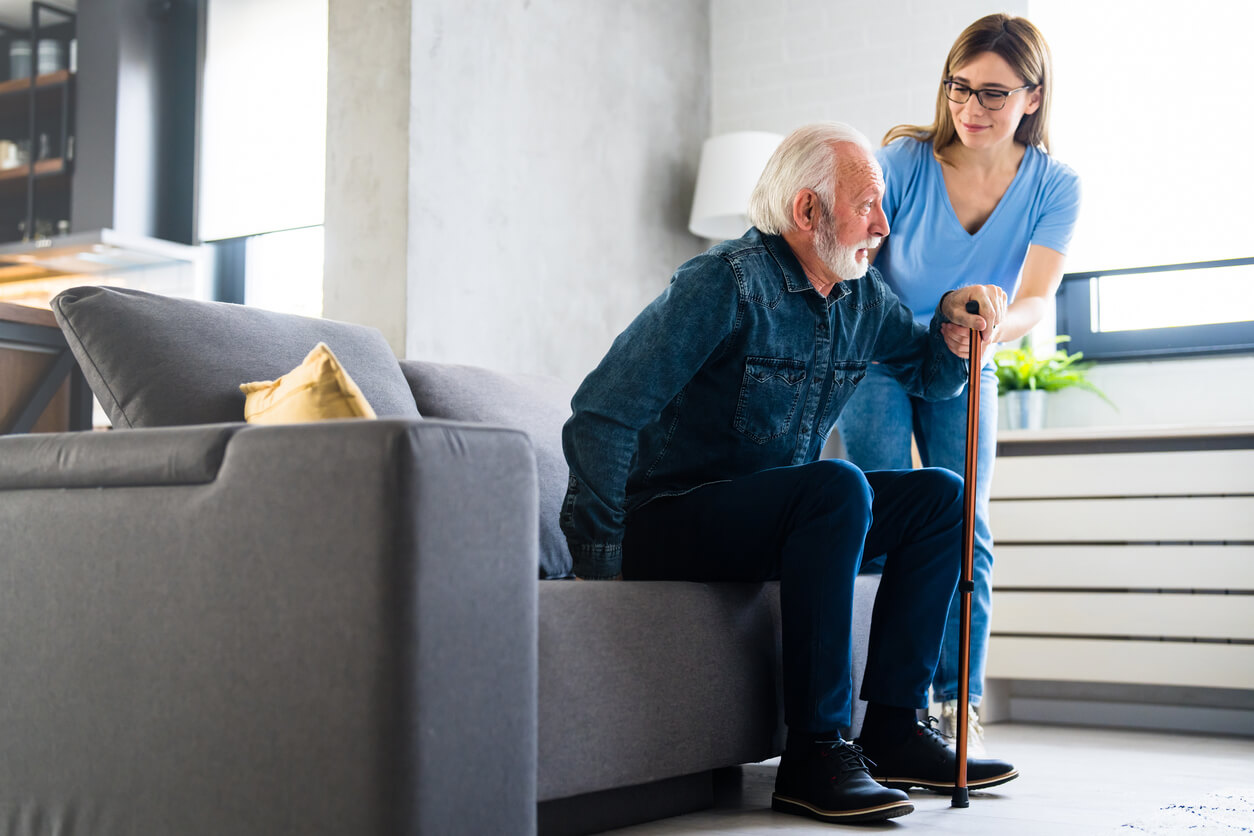 Ensuring the safety of our aging loved ones isn’t just important, but it’s essential for their independence and well-being. It’s not about overhauling your entire home; rather, it’s focusing on small, impactful modifications that significantly boost safety. From the living room to the bedroom, every corner of the home has the potential to be a safer space.
Ensuring the safety of our aging loved ones isn’t just important, but it’s essential for their independence and well-being. It’s not about overhauling your entire home; rather, it’s focusing on small, impactful modifications that significantly boost safety. From the living room to the bedroom, every corner of the home has the potential to be a safer space.By taking a closer look and making thoughtful adjustments, we create a secure environment where our elders can thrive. Let’s embark on this journey together, exploring simple yet effective ways to safeguard our homes for the golden years.
What’s a Home Safety Assessment?
This is a crucial step in ensuring a secure environment for the elderly. Think of it as playing detective in your own home, where you:
- Scout for any potential risks or hazards.
- Review each room with a critical eye, focusing on safety.
- Check for obstacles that could lead to falls or accidents.
- Evaluate the accessibility of essential items and facilities.
Why Home Safety Evaluations Matter
Spotting the Dangers
Identifying potential hazards in your home is key to preventing accidents before they happen. By keeping an eye out for these risks, you can make quick fixes to ensure safety. It involves:
- Check floors for loose carpets or slippery areas that could lead to falls.
- Ensuring electrical cords are neatly tucked away, not stretched across walkways.
- Verifying that all stairways are well-lit and have sturdy handrails.
- Looking for sharp corners on furniture that can cause injuries.
Sharing the Plan
Communicating your safety check plans with household members is crucial. It ensures everyone understands the importance of the changes and is on board with them. This involves:
- Convening a family gathering to address the forthcoming safety evaluations.
- Explain the reasons behind each change to garner support.
- Assigning specific tasks to family members, making it a team effort.
- Regular updates on progress and any new findings.
Putting the Plan into Action
Taking action on your home safety plan is crucial. Once you’ve identified what needs to be done, jump into action. Here’s how:
- Prioritize tasks based on risk and urgency.
- Involve family members in making changes assigning roles based on ability.
- Start with simple fixes like decluttering walkways and securing rugs.
- Schedule more complex projects, such as installing grab bars or improving lighting.
- Celebrate small wins to motivate the team.
Is Your Home Ready for Golden Years?
Can the Elderly Live Safely Here?
This is a crucial question to assess the suitability of a home for older individuals. Beyond mere comfort, safety encompasses various aspects such as accessibility, slip-resistant flooring, grab bars in bathrooms, adequate lighting, and emergency response systems. Additionally, considerations for potential hazards like stairs or uneven surfaces are vital.
Ensuring a supportive environment with easy access to medical care and community resources further enhances safety. Ultimately, creating an environment that prioritizes both comfort and safety fosters a sense of security and independence for elderly residents, facilitating their well-being and quality of life.
Design for Everyone
Universal design principles strive to establish environments that are accessible and functional for individuals of diverse ages and abilities. By incorporating features such as wider doorways, lever-style door handles, zero-step entrances, and open floor plans, homes become more accommodating for individuals with mobility challenges or disabilities. Installing non-slip flooring, adjustable-height countertops, and lever faucets also enhance accessibility and safety.
These simple changes not only promote independence and convenience for older adults but also benefit individuals with temporary injuries or young children. Universal design fosters inclusivity, ensuring that everyone can navigate and enjoy living spaces comfortably and safely.
Guides to Help You Along
Guides such as the AARP HomeFit Guide and caregiver checklists serve as invaluable resources for creating safer living environments. These tools offer comprehensive recommendations and checklists to assess homes and identify potential hazards. They guide modifications and improvements to enhance safety and accessibility, covering areas such as lighting, flooring, bathrooms, kitchens, and overall home layout.
By following these roadmaps, individuals can systematically address safety concerns and make informed decisions to adapt their homes to suit better the needs of aging residents or those with disabilities. These guides empower individuals to create environments that promote well-being and independence proactively.
Quick Safety Fixes
Implementing quick safety fixes involves identifying and addressing potential hazards efficiently to enhance overall safety. Minor modifications such as fitting grab bars in bathrooms, incorporating non-slip mats, anchoring loose rugs, and guaranteeing sufficient lighting in hallways and staircases can markedly diminish the likelihood of accidents. Other quick fixes include:
- Rearranging furniture to create clear pathways.
- Installing brighter bulbs.
- Removing clutter to minimize tripping hazards.
By being proactive and strategic in these safety upgrades, individuals can quickly improve the safety and functionality of their homes, promoting a safer living environment for all occupants, especially older adults and those with mobility issues.

Room-by-Room Safety Guide
Bedroom Bliss
In creating a haven within the bedroom, several considerations contribute to a comfortable and secure environment:
- Accessible Lighting: Install bedside lamps or light switches within easy reach of the bed to provide illumination for nighttime navigation without the need to stumble in the dark.
- Clutter-Free Floors: Keep the bedroom floor clear of any obstacles or clutter to prevent tripping hazards, ensuring smooth and safe movement, especially during nighttime visits to the bathroom.
- Secure Bedside Furniture: Ensure that bedside tables or shelves are securely anchored to the wall to prevent tipping accidents, particularly if they’re used to store essential items like medications, glasses, or phones.
- Comfortable Bed Height: Adjust the bed to a height that makes it easy to get in and out of, considering the needs and limitations of older adults or individuals with mobility issues.
Bathroom Safety
Ensuring bathroom safety is crucial in preventing falls and promoting independence. Here are some essential measures to enhance safety:
- Install Grab Bars: Place sturdy grab bars near the toilet, shower, and bathtub to provide support when sitting down, standing up, or maneuvering in and out of the bathing area.
- Slip-Proof Mats: Utilize slip-resistant mats or decals within the bathtub or shower to mitigate the potential for slipping on wet surfaces.
- Adjustable Showerheads: Install handheld or adjustable-height showerheads to facilitate bathing while sitting or standing, accommodating individuals with varying mobility needs.
- Raised Toilet Seat: Think about installing a raised toilet seat to facilitate safe sitting and standing for individuals with mobility challenges.
- Bright Lighting: Ensure adequate lighting in the bathroom, including nightlights or motion-activated lights, to improve visibility and reduce the risk of accidents, especially during nighttime bathroom visits.
Living Room Comfort
Creating a comfortable and safe living room environment involves several key considerations:
- Clear Paths: Keep pathways clear of furniture, cords, and other obstacles to facilitate easy movement and reduce the risk of tripping hazards.
- Bright Lighting: Ensure ample lighting throughout the living room, including overhead lights, lamps, and task lighting, to improve visibility and reduce the risk of accidents, especially for older adults with decreased vision.
- Secure Rugs: Use non-slip pads or secure rugs firmly to the floor to prevent them from sliding and causing trips or falls.
- Comfortable Seating: Choose furniture with appropriate support and cushioning to provide comfortable seating options, especially for individuals with mobility issues or back problems.
- Accessible Remote Controls: Keep remote controls, entertainment systems, and other frequently used items within easy reach to avoid unnecessary bending or stretching.
Kitchen Caution
Maintaining a safe kitchen environment is paramount to prevent accidents and injuries. Here are some key precautions to take:
- Secure Cabinets: Use childproof locks or latches to secure cabinets containing cleaning products, sharp utensils, or other hazardous items, keeping them out of reach of children or pets.
- Proper Storage: Store knives, scissors, and other sharp objects in designated slots or blocks to prevent accidental cuts or injuries.
- Keep Floors Clear: Avoid cluttering kitchen floors with items such as rugs or extension cords, which can pose tripping hazards, especially in high-traffic areas.
- Safe Appliance Use: Follow manufacturer instructions for the safe use of kitchen appliances, including stovetops, ovens, and microwaves, and ensure proper ventilation to prevent fire hazards.
- Childproof Appliances: Use stove knob covers and oven locks to prevent young children from accidentally turning on appliances.
Dining Room Safety
Creating a safe dining room environment enhances the enjoyment of family meals while minimizing the risk of accidents. Here are some essential safety considerations:
- Clear Pathways: Arrange dining furniture to allow for easy navigation and ensure clear pathways between the table, chairs, and other furnishings to prevent tripping hazards.
- Stable Seating: Choose stable and sturdy chairs for dining, ensuring they are in good condition with no wobbling or instability to prevent falls while seated.
- Adequate Lighting: Install bright lighting fixtures or lamps to illuminate the dining area, enhancing visibility and reducing the risk of spills or accidents, especially during evening meals.
- Secure Furniture: Secure tall furniture, like cabinets or shelving units, to the wall to avoid tipping accidents, especially in households with children or pets.
Basement Basics
Ensuring safety in the basement is essential for creating a functional and secure living space. Here are some key considerations:
- Ample Lighting: Install bright overhead lights and additional lighting fixtures as needed to illuminate the entire basement area, including staircases and storage areas, enhancing visibility and reducing the risk of accidents.
- Clear Exits: Keep basement exits and pathways clear of clutter and obstructions to ensure easy and unobstructed access to escape routes in case of emergencies, such as fires or flooding.
- Secure Staircases: Ensure that staircases leading to the basement are sturdy, with secure handrails and non-slip surfaces to prevent falls and accidents, especially in homes with older adults or young children.
- Waterproofing: Implement measures to waterproof the basement to avoid moisture accumulation, which may result in mold growth and structural deterioration, posing health and safety hazards to occupants.
Compassionate Home Care
Compassionate home care for the elderly goes beyond physical changes; it encompasses creating an environment where they feel respected, valued, and included in their safety and well-being. Every safety tweak and adjustment should be made with the intention of showing care and consideration for their needs.
Home is not just a physical space; it’s where the heart is, and everyone deserves to feel safe, comfortable and loved there. Here’s your go-to guide for making your home a haven for the elderly, focusing on small steps that can make a big impact:
- Open Communication: Foster open and honest communication with the elderly individual(s) living in the home. Encourage them to express their concerns, preferences, and any challenges they may be facing in navigating their living environment.
- Respect and Dignity: Treat elderly family members or residents with the utmost respect and dignity. Involve them in decision-making processes regarding safety modifications and adjustments to their living space, ensuring their autonomy and agency are upheld.
- Personalized Approach: Recognize that each individual’s needs and abilities may vary. Tailor safety measures and home modifications to accommodate their specific requirements, whether it’s related to mobility, vision, hearing, or cognitive function.
- Comfort and Familiarity: Create a comfortable and familiar environment that feels like home to the elderly person. Incorporate personal touches, such as cherished photographs, favorite decorations, or familiar furniture arrangements, to evoke feelings of security and belonging.
- Empathy and Patience: Practice empathy and patience when assisting elderly individuals with daily tasks or navigating safety concerns. Understand that adjustments may take time to adapt to and may require ongoing support and encouragement.
- Regular Assessments: Conduct regular assessments of the home environment to identify potential safety hazards or areas for improvement. This may involve reviewing the layout, lighting, accessibility features, and emergency preparedness measures.
- Mobility Assistance: Assist with mobility as needed, whether it’s installing grab bars in bathrooms, handrails on staircases, or ramps for wheelchair access. Ensure that pathways are clear and free of obstacles to facilitate safe movement throughout the home.
- Medication Management: Establish a system for managing medications safely and effectively, including organizing pill dispensers, maintaining a medication schedule, and monitoring for any adverse reactions or interactions.
- Emotional Support: Offer emotional support and companionship to combat feelings of loneliness or isolation that elderly individuals may experience. Engage in meaningful conversations, activities, and social interactions to promote mental and emotional well-being.
- Community Resources: Familiarize yourself with local community resources and support services available to assist elderly individuals with various needs, such as transportation, home healthcare, meal delivery, and social programs.
By embracing a compassionate approach to home care for the elderly, you can create a nurturing and supportive environment where safety, comfort, and love prevail. Together, let’s prioritize safety and well-being to ensure that every individual feels valued and cherished in their own home.

